Distributed Information Management: Cloud vs. Cluster Systems
VerifiedAdded on 2021/06/17
|7
|1302
|59
Report
AI Summary
This report provides a comparative analysis of cloud computing and cluster computing systems, covering their definitions, architectures, and key differences. The report begins by defining cloud computing as a virtual integration of computer systems for shared resources, contrasting it with cluster computing, which uses parallel computers connected via a high-speed network. The comparison highlights the advantages and disadvantages of each system, focusing on aspects like reliability, security, scalability, and heterogeneity. The report then delves into critical views of management issues and technical implications for both systems. For cluster computing, the report discusses challenges in program code development, fault recovery, and system performance. In cloud computing, it addresses issues related to load balancing, security concerns, and efficient resource distribution. The report concludes by emphasizing the importance of addressing these challenges for effective system implementation and management, supported by relevant references.
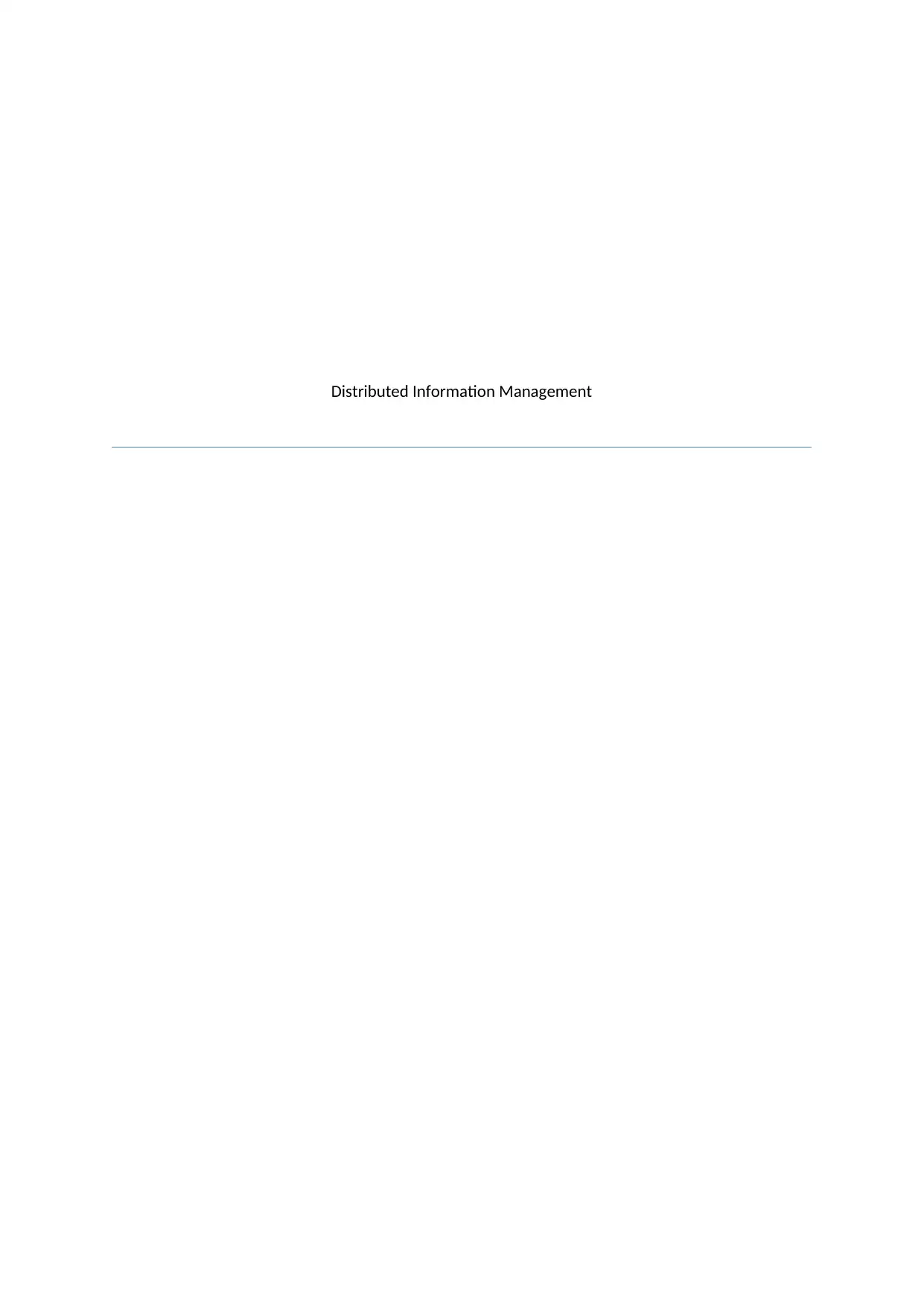
Distributed Information Management
Paraphrase This Document
Need a fresh take? Get an instant paraphrase of this document with our AI Paraphraser
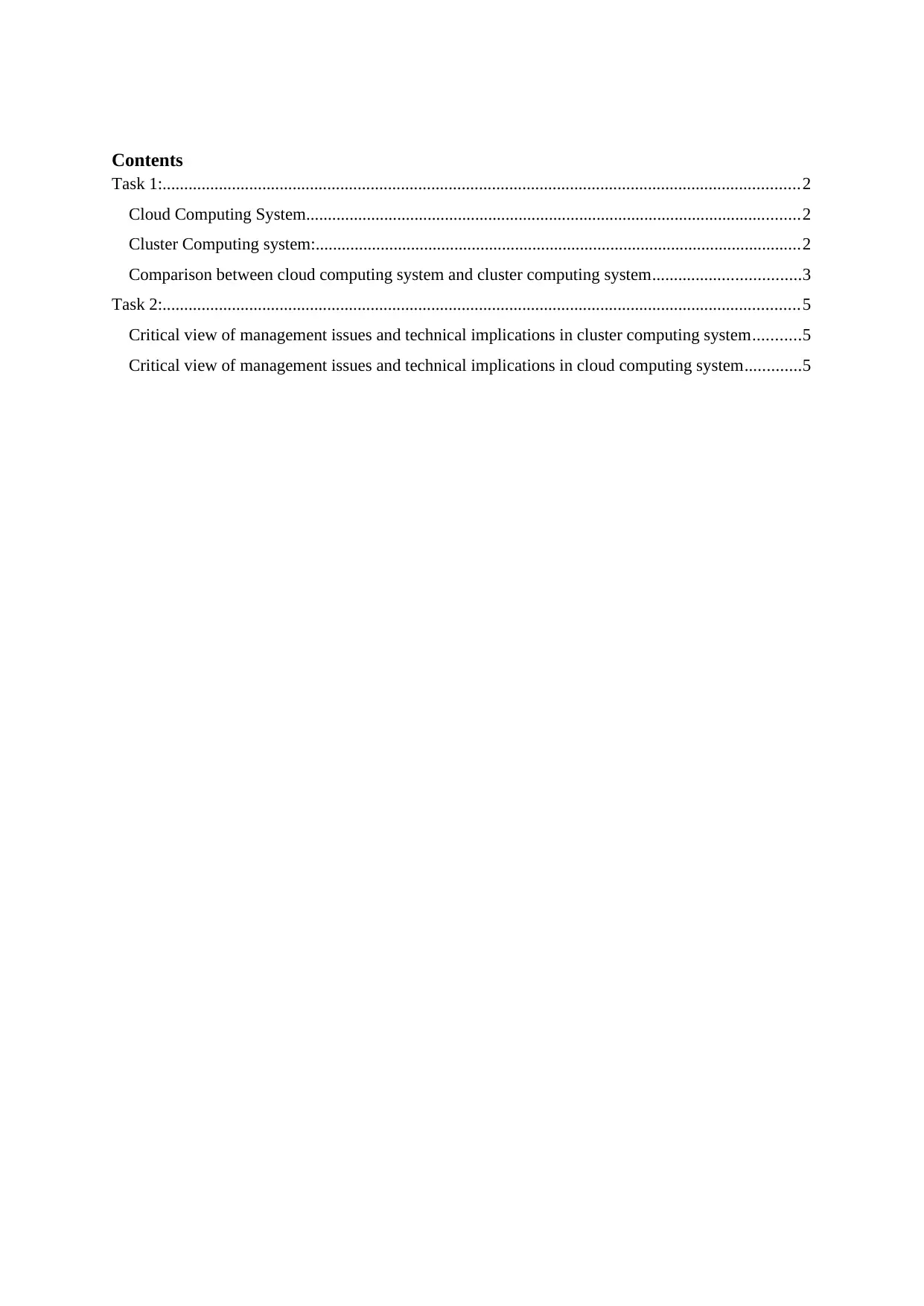
Contents
Task 1:...................................................................................................................................................2
Cloud Computing System..................................................................................................................2
Cluster Computing system:................................................................................................................2
Comparison between cloud computing system and cluster computing system..................................3
Task 2:...................................................................................................................................................5
Critical view of management issues and technical implications in cluster computing system...........5
Critical view of management issues and technical implications in cloud computing system.............5
Task 1:...................................................................................................................................................2
Cloud Computing System..................................................................................................................2
Cluster Computing system:................................................................................................................2
Comparison between cloud computing system and cluster computing system..................................3
Task 2:...................................................................................................................................................5
Critical view of management issues and technical implications in cluster computing system...........5
Critical view of management issues and technical implications in cloud computing system.............5
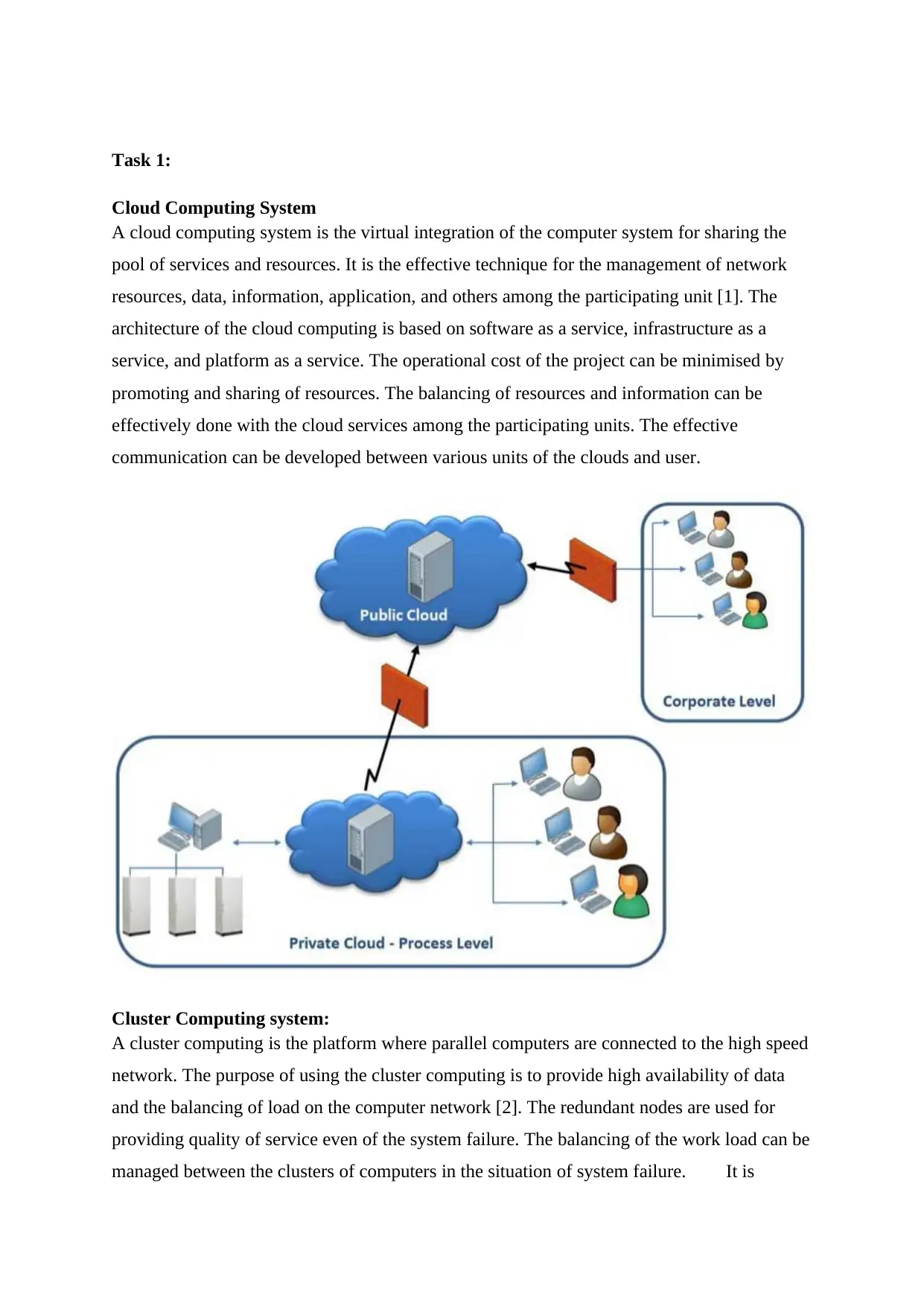
Task 1:
Cloud Computing System
A cloud computing system is the virtual integration of the computer system for sharing the
pool of services and resources. It is the effective technique for the management of network
resources, data, information, application, and others among the participating unit [1]. The
architecture of the cloud computing is based on software as a service, infrastructure as a
service, and platform as a service. The operational cost of the project can be minimised by
promoting and sharing of resources. The balancing of resources and information can be
effectively done with the cloud services among the participating units. The effective
communication can be developed between various units of the clouds and user.
Cluster Computing system:
A cluster computing is the platform where parallel computers are connected to the high speed
network. The purpose of using the cluster computing is to provide high availability of data
and the balancing of load on the computer network [2]. The redundant nodes are used for
providing quality of service even of the system failure. The balancing of the work load can be
managed between the clusters of computers in the situation of system failure. It is
Cloud Computing System
A cloud computing system is the virtual integration of the computer system for sharing the
pool of services and resources. It is the effective technique for the management of network
resources, data, information, application, and others among the participating unit [1]. The
architecture of the cloud computing is based on software as a service, infrastructure as a
service, and platform as a service. The operational cost of the project can be minimised by
promoting and sharing of resources. The balancing of resources and information can be
effectively done with the cloud services among the participating units. The effective
communication can be developed between various units of the clouds and user.
Cluster Computing system:
A cluster computing is the platform where parallel computers are connected to the high speed
network. The purpose of using the cluster computing is to provide high availability of data
and the balancing of load on the computer network [2]. The redundant nodes are used for
providing quality of service even of the system failure. The balancing of the work load can be
managed between the clusters of computers in the situation of system failure. It is
⊘ This is a preview!⊘
Do you want full access?
Subscribe today to unlock all pages.

Trusted by 1+ million students worldwide
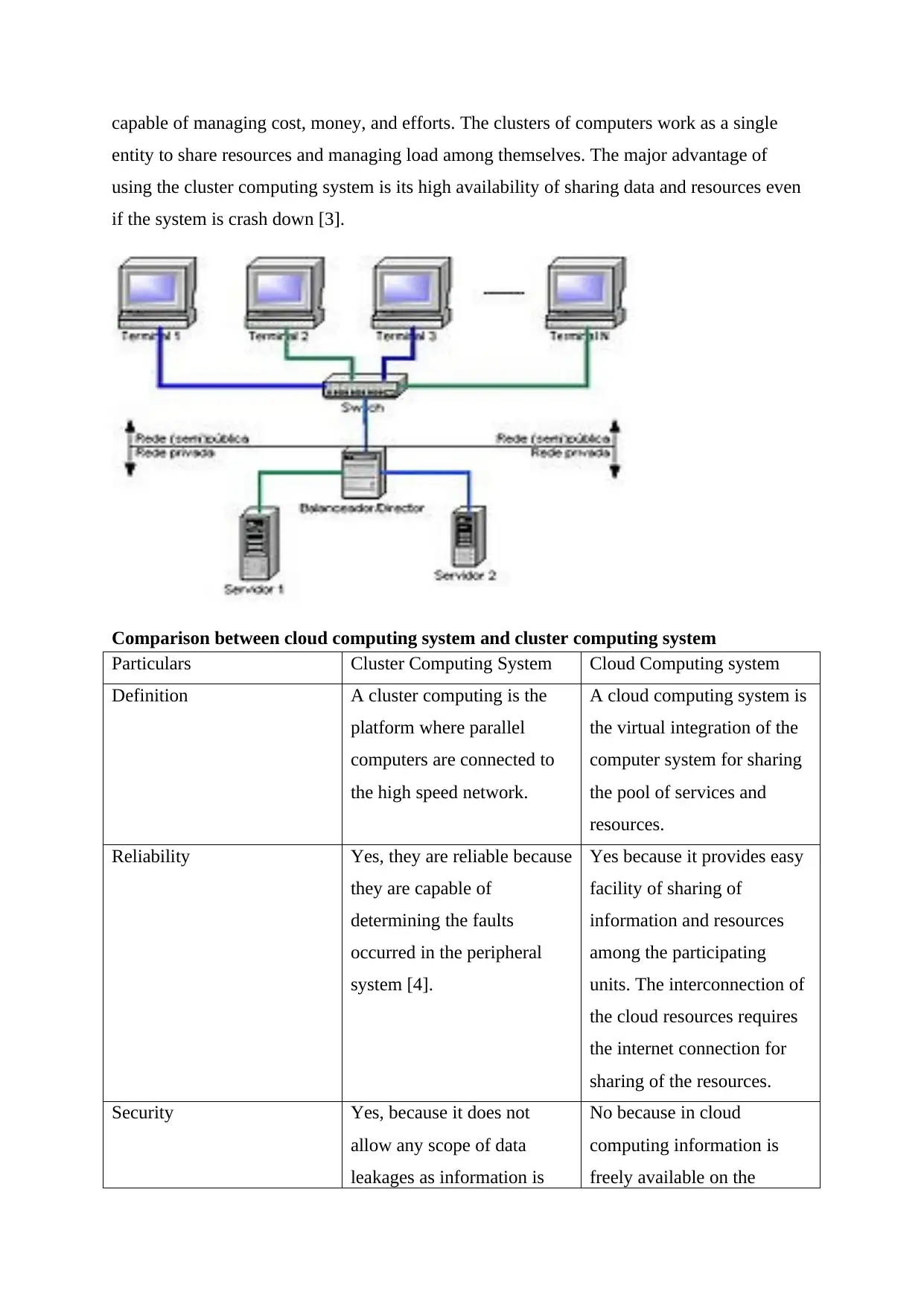
capable of managing cost, money, and efforts. The clusters of computers work as a single
entity to share resources and managing load among themselves. The major advantage of
using the cluster computing system is its high availability of sharing data and resources even
if the system is crash down [3].
Comparison between cloud computing system and cluster computing system
Particulars Cluster Computing System Cloud Computing system
Definition A cluster computing is the
platform where parallel
computers are connected to
the high speed network.
A cloud computing system is
the virtual integration of the
computer system for sharing
the pool of services and
resources.
Reliability Yes, they are reliable because
they are capable of
determining the faults
occurred in the peripheral
system [4].
Yes because it provides easy
facility of sharing of
information and resources
among the participating
units. The interconnection of
the cloud resources requires
the internet connection for
sharing of the resources.
Security Yes, because it does not
allow any scope of data
leakages as information is
No because in cloud
computing information is
freely available on the
entity to share resources and managing load among themselves. The major advantage of
using the cluster computing system is its high availability of sharing data and resources even
if the system is crash down [3].
Comparison between cloud computing system and cluster computing system
Particulars Cluster Computing System Cloud Computing system
Definition A cluster computing is the
platform where parallel
computers are connected to
the high speed network.
A cloud computing system is
the virtual integration of the
computer system for sharing
the pool of services and
resources.
Reliability Yes, they are reliable because
they are capable of
determining the faults
occurred in the peripheral
system [4].
Yes because it provides easy
facility of sharing of
information and resources
among the participating
units. The interconnection of
the cloud resources requires
the internet connection for
sharing of the resources.
Security Yes, because it does not
allow any scope of data
leakages as information is
No because in cloud
computing information is
freely available on the
Paraphrase This Document
Need a fresh take? Get an instant paraphrase of this document with our AI Paraphraser

not provided on the network network which can be easily
hacked by the attackers.
Scalability No because the cluster once
created will not be appended
Yes because it is a multi-user
platform which provides
facility of adding new user to
the cloud
Heterogeneity No because it is the
amalgamation of similar type
of devices and computer
units
Yes because it the
amalgamation of different
units such as network
resources, data, information,
application, and others which
can be shared effectively
among the user [5].
Homogeneity Yes because it is the
amalgamation of similar type
of devices and computer
units
No because it the
amalgamation of different
units such as network
resources, data, information,
application, and others which
can be shared effectively
among the user. The
deadlock condition arises due
to the interoperability of the
resources [6].
Advantages Manageable with respect to
cost, efforts, and money
Works as a single entity
Availability of data and
information even if the
system fails
Additional resources can be
available
Balancing of the resources
among participating units
Sharing of resources
Disadvantages Programming error It is less reliable
hacked by the attackers.
Scalability No because the cluster once
created will not be appended
Yes because it is a multi-user
platform which provides
facility of adding new user to
the cloud
Heterogeneity No because it is the
amalgamation of similar type
of devices and computer
units
Yes because it the
amalgamation of different
units such as network
resources, data, information,
application, and others which
can be shared effectively
among the user [5].
Homogeneity Yes because it is the
amalgamation of similar type
of devices and computer
units
No because it the
amalgamation of different
units such as network
resources, data, information,
application, and others which
can be shared effectively
among the user. The
deadlock condition arises due
to the interoperability of the
resources [6].
Advantages Manageable with respect to
cost, efforts, and money
Works as a single entity
Availability of data and
information even if the
system fails
Additional resources can be
available
Balancing of the resources
among participating units
Sharing of resources
Disadvantages Programming error It is less reliable

Difficulty in finding error Availability of internet
Architecture Distributed and parallel
computing
It is based on Infrastructure
as a service, platform as a
service, and software as a
service
Fault Tolerance It is difficult to detect
occurrence of the fault
It depends on two process of
redundancy and replication.
Task 2:
Critical view of management issues and technical implications in cluster computing
system
The middleware of the cluster computing provides visualization as single entity of the system
as it is an amalgamation of cluster of numerous computers. The development of program
codes for managing communication is the problematic scenario. The request response service
management dramatically changes with the real time. The adding of additional resources after
the development of cluster can directly affect the performance of the entire system. It is
capable of resolving fault occurred in the component system by deploying the fault recovery
system for the cluster management. The redundant nodes are used for providing quality of
service even of the system failure. The balancing of the work load can be managed between
the clusters of computers in the situation of system failure [7]. The multiple machines work
as a single virtual environment for fetching of relevant information. The failure of the system
does not break the communication or connectivity between other systems because other
system effectively manages the work load among them.
Critical view of management issues and technical implications in cloud computing
system
The sharing of resources, network, application, data, and information can be effectively done
with the help of cloud architecture. The load balancing approach should is the major problem
for managing dynamic scalability program. The cloud system performance is degraded with
the increasing growth of number of nodes for sharing of cloud services and resources. The
security is the major concern for deploying the cloud architecture in the business unit for
sharing of resources. The information posted on the cloud will not be remain confidential due
Architecture Distributed and parallel
computing
It is based on Infrastructure
as a service, platform as a
service, and software as a
service
Fault Tolerance It is difficult to detect
occurrence of the fault
It depends on two process of
redundancy and replication.
Task 2:
Critical view of management issues and technical implications in cluster computing
system
The middleware of the cluster computing provides visualization as single entity of the system
as it is an amalgamation of cluster of numerous computers. The development of program
codes for managing communication is the problematic scenario. The request response service
management dramatically changes with the real time. The adding of additional resources after
the development of cluster can directly affect the performance of the entire system. It is
capable of resolving fault occurred in the component system by deploying the fault recovery
system for the cluster management. The redundant nodes are used for providing quality of
service even of the system failure. The balancing of the work load can be managed between
the clusters of computers in the situation of system failure [7]. The multiple machines work
as a single virtual environment for fetching of relevant information. The failure of the system
does not break the communication or connectivity between other systems because other
system effectively manages the work load among them.
Critical view of management issues and technical implications in cloud computing
system
The sharing of resources, network, application, data, and information can be effectively done
with the help of cloud architecture. The load balancing approach should is the major problem
for managing dynamic scalability program. The cloud system performance is degraded with
the increasing growth of number of nodes for sharing of cloud services and resources. The
security is the major concern for deploying the cloud architecture in the business unit for
sharing of resources. The information posted on the cloud will not be remain confidential due
⊘ This is a preview!⊘
Do you want full access?
Subscribe today to unlock all pages.

Trusted by 1+ million students worldwide
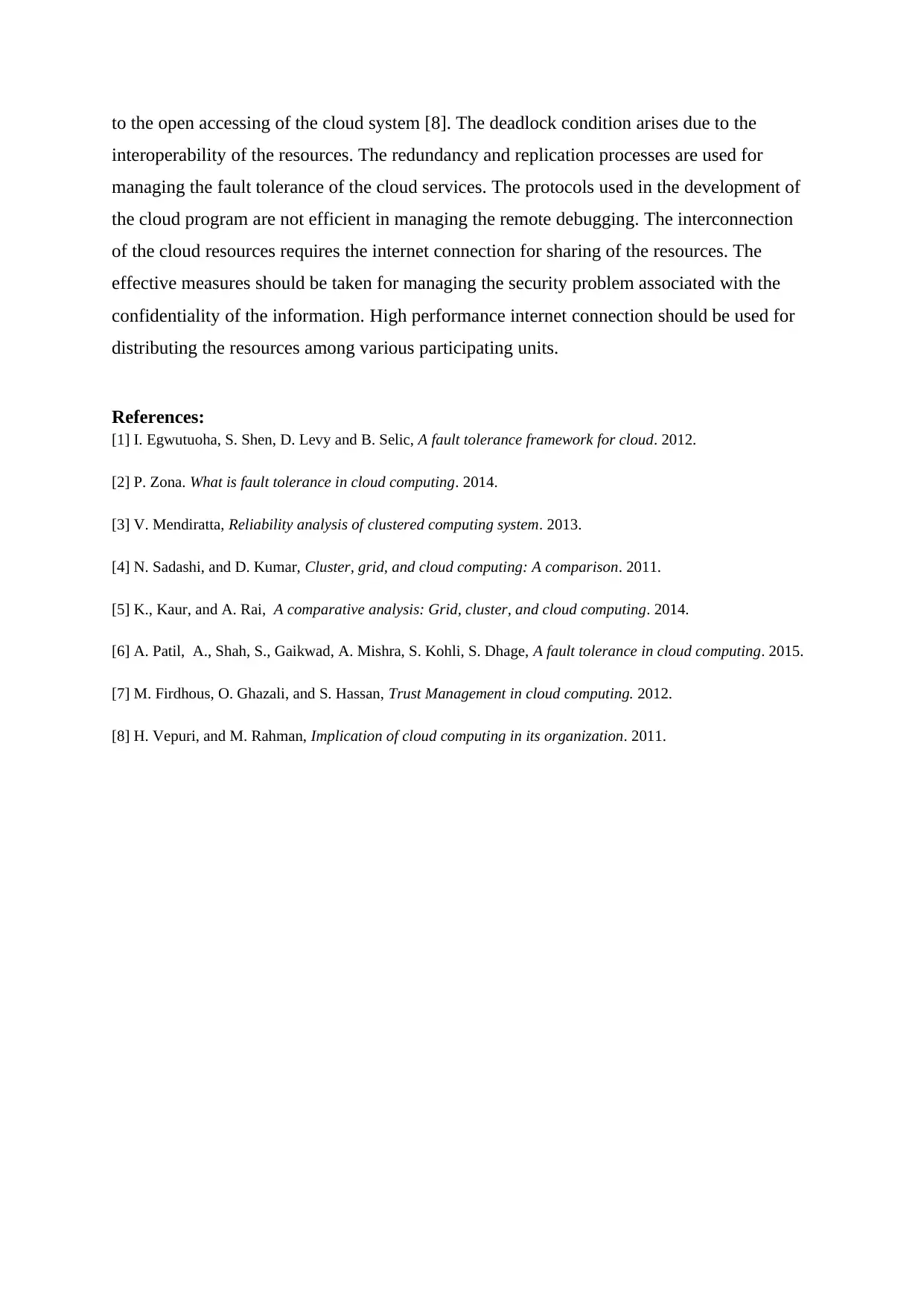
to the open accessing of the cloud system [8]. The deadlock condition arises due to the
interoperability of the resources. The redundancy and replication processes are used for
managing the fault tolerance of the cloud services. The protocols used in the development of
the cloud program are not efficient in managing the remote debugging. The interconnection
of the cloud resources requires the internet connection for sharing of the resources. The
effective measures should be taken for managing the security problem associated with the
confidentiality of the information. High performance internet connection should be used for
distributing the resources among various participating units.
References:
[1] I. Egwutuoha, S. Shen, D. Levy and B. Selic, A fault tolerance framework for cloud. 2012.
[2] P. Zona. What is fault tolerance in cloud computing. 2014.
[3] V. Mendiratta, Reliability analysis of clustered computing system. 2013.
[4] N. Sadashi, and D. Kumar, Cluster, grid, and cloud computing: A comparison. 2011.
[5] K., Kaur, and A. Rai, A comparative analysis: Grid, cluster, and cloud computing. 2014.
[6] A. Patil, A., Shah, S., Gaikwad, A. Mishra, S. Kohli, S. Dhage, A fault tolerance in cloud computing. 2015.
[7] M. Firdhous, O. Ghazali, and S. Hassan, Trust Management in cloud computing. 2012.
[8] H. Vepuri, and M. Rahman, Implication of cloud computing in its organization. 2011.
interoperability of the resources. The redundancy and replication processes are used for
managing the fault tolerance of the cloud services. The protocols used in the development of
the cloud program are not efficient in managing the remote debugging. The interconnection
of the cloud resources requires the internet connection for sharing of the resources. The
effective measures should be taken for managing the security problem associated with the
confidentiality of the information. High performance internet connection should be used for
distributing the resources among various participating units.
References:
[1] I. Egwutuoha, S. Shen, D. Levy and B. Selic, A fault tolerance framework for cloud. 2012.
[2] P. Zona. What is fault tolerance in cloud computing. 2014.
[3] V. Mendiratta, Reliability analysis of clustered computing system. 2013.
[4] N. Sadashi, and D. Kumar, Cluster, grid, and cloud computing: A comparison. 2011.
[5] K., Kaur, and A. Rai, A comparative analysis: Grid, cluster, and cloud computing. 2014.
[6] A. Patil, A., Shah, S., Gaikwad, A. Mishra, S. Kohli, S. Dhage, A fault tolerance in cloud computing. 2015.
[7] M. Firdhous, O. Ghazali, and S. Hassan, Trust Management in cloud computing. 2012.
[8] H. Vepuri, and M. Rahman, Implication of cloud computing in its organization. 2011.
1 out of 7
Related Documents
Your All-in-One AI-Powered Toolkit for Academic Success.
+13062052269
info@desklib.com
Available 24*7 on WhatsApp / Email
![[object Object]](/_next/static/media/star-bottom.7253800d.svg)
Unlock your academic potential
Copyright © 2020–2025 A2Z Services. All Rights Reserved. Developed and managed by ZUCOL.





